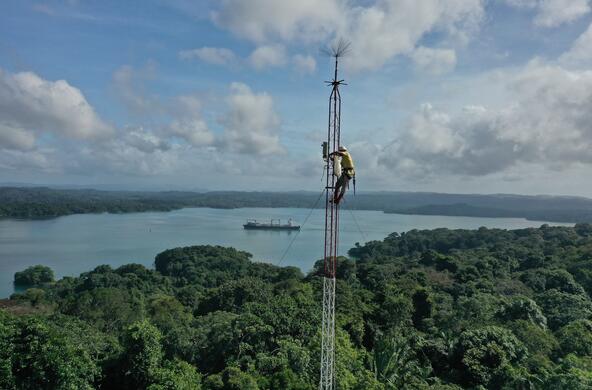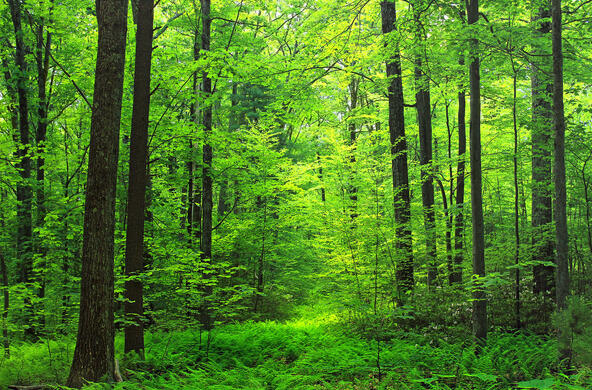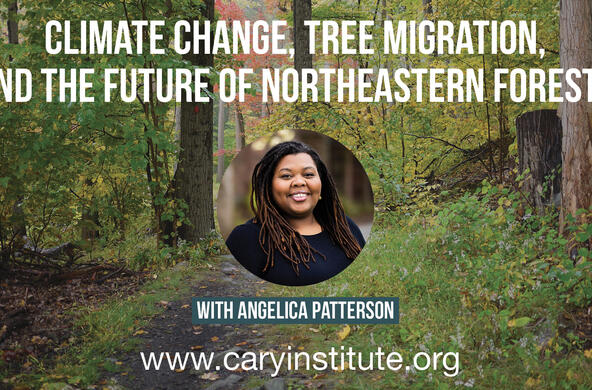Biochar (formerly known as charcoal) has attracted a lot of recent attention, owing to increasing interest in carbon sequestration in soils for greenhouse gas mitigation.
With the use of biomass fuels, the production and burial of biochar could store significant amounts of carbon that might otherwise be emitted to the atmosphere as carbon dioxide.[1] This sink for carbon is potentially highly resistant to decomposition. Large accumulations of ancient charcoal persist in the Brazilian Amazon, forming terra preta or black earth soils of exceptional fertility.[2] Hardy New Englanders knew that charring the base of a wooden fence post would prolong its longevity in soil. And creosote, a distillate from partially burned wood, was historically used as a wood preservative.
Charcoal is produced naturally in forest and rangeland fires. In the low-temperature environment of most natural fires, 10-20% of the carbon in burned forests may remain on-site as charcoal.[3] Recent estimates of global charcoal production are 0.05-0.27 gigatons (1015 gC)[4] annually, about 0.3% of global net primary production. The persistence of biochar is not well characterized, showing mean residence times ranging from 8 to 4000 years.[5] Some charcoal appears remarkably resistant to decomposition, with radiocarbon ages in excess of those of co-occurring soil humic materials.[6] Some washes to the sea, where it accumulates in marine sediments.[7]
The potential for biochar to serve as a major offset to carbon emissions from fossil fuel combustion depends on the answers to several important questions: What is the origin of the biomass used for biochar generation? What energy costs and net CO2 emissions would arise with a new industry for the production, distribution, and storage of biochar? Will the biochar be spread across the soil surface or mixed into the soil? How long does the carbon in charcoal persist in the litter or soil before it is released to the atmosphere as CO2?
Biochar is currently used to refer to a wide range of materials, including those produced under low-temperature combustion, resembling most natural wildfires, and both low and high temperature biochars produced by pyrolysis. Pyrolysis, burning biomass in the absence of oxygen, does not produce as much energy as would direct combustion of the same materials in the presence of oxygen, for instance, in a boiler generating heat or coupled to the generation of electricity. The total amount of energy produced per unit of carbon dioxide emitted to the atmosphere is lower, relative to direct combustion, because there is chemical energy remaining in the biochar—that is why charcoal is a desirable cooking fuel, more so than wood itself. The amount of carbon accumulated on the landscape through the use of biochar to increase soil carbon storage and plant productivity must be greater than the incremental carbon dioxide emissions from fuel burned to compensate for the reduced energy yield, or there is no mitigation of potential climate change.
While pyrolysis involves lower energy yields, high-temperature pyrolysis yields as much as 60% of the carbon in resistant charcoal. Unfortunately, high-temperature pyrolysis is not normally the preferred method for the combustion of biomass to produce energy.[8] Slow, low-temperature pyrolysis yields >30% less energy than complete combustion, but 41 to 64% of the carbon is captured in biochar, which may be applied as a soil amendment.[9]
Making and storing biochar as a purposeful means of sequestering additional soil carbon needs careful evaluation. Biochar will offer incremental carbon sequestration only if it transfers a greater fraction of plant biomass to resistant decomposition pools than the same amount of raw material left to nature, or if the addition of biochar to soils causes native soil organic matter to decompose more slowly—a reverse “priming effect.”[10] In addition, for an increase in soil carbon stocks to have a positive effect on atmospheric greenhouse gas concentrations, mainly by reducing carbon dioxide levels, the impacts of mitigation activities must be accompanied by no net change, or an increase, in terrestrial vegetation carbon stocks and no net increase in fossil fuel combustion. Direct combustion of biomass waste to produce energy in many, if not most, situations will result in greater net reductions in greenhouse gas emissions than will production of biochar.
In fact, there are remarkably few long-term studies of the actual rate of decomposition of biochar produced from pyrolysis. While the breakdown of charcoal in soils is slow, it is not inert.[11] A few studies of the initial loss of biochar indicate rates of 12-16%/yr for corn residues and wood, respectively, produced under both high- and low-temperature combustion,[12] and 12%/yr for wood biochar produced by natural fires in a variety of Kenyan soils.[13] These rates are similar to rates of wood decay for a variety of species in forest ecosystems.[14] The decomposition of the resistant fraction of biochar is much slower, but little is known about its decay rate compared to that of humic materials. The few well-publicized deposits of ancient charcoal may stem from large original inputs of charcoal, rather than from slow rates of decay.12 Decay rates are likely to be considerably faster if the biochar is spread across the litter or soil surface rather than mixed into the soil. If it is mixed into the soil, the disturbance and decomposition of soil organic matter that accompany this mixing must be included in the net greenhouse gas balance.
Some estimate the potential for a net reduction of one to two gigatons (109 mt/yr) of carbon emissions (as CO2) by burning biomass as a substitute for fossil fuels, with an ancillary benefit of producing some biochar that could be stored in soils. At normal burning efficiencies, without biochar production, this emissions reduction would require the harvest of about 4% of the total plant growth on land each year—1.6 gigatons C/yr. By comparison, the total harvest of plant growth for food crops is about 0.8 gigatons/year and the total human harvest of terrestrial net primary production is 8.3 to 11.5 gigatons/year.[15] Clearing new land for agriculture to replace lands devoted to biomass and biochar production would cause a substantial release of carbon dioxide to the atmosphere.[16]
A recent life-cycle analysis of biochar production identified four potential benefits from biochar production: long-term carbon sequestration from stable C in the biochar, renewable energy generation, improved fertility, water-holding capacity and soil tilth, and biomass waste management.[17] The potential benefits of combustion of waste biomass to produce energy in order to reduce net carbon dioxide emissions to the atmosphere, and the benefits of charcoal to soil fertility are well known.[18] Here, we question only the significance of the potential carbon sink from charcoal in soils, where it is likely to have only a limited and, in some cases, net negative role in greenhouse-gas mitigation. Expensive to produce, inefficient to ship, and difficult to spread across the landscape, biochar is best reserved as a local means to dispose of crop and forestry waste that can not be combusted to derive usable energy . In that role it is likely to mitigate only a very small fraction of current CO2 emissions to the atmosphere.
Rather than using biomass to produce biochar, perhaps we should encourage more immediate opportunities to use biomass to mitigate carbon emissions. Bioelectricity generation and afforestation are two opportunities already in place for carbon offsets and greenhouse-gas reductions.[19] Substantial amounts of carbon can also be stored in lumber, furniture, and other wood products with long economic lifetimes. For the United States, the storage of carbon in long-lived wood products was about 0.06 gigatons/yr during the 1990s[20]—contributing to the nation’s GNP, rather than simply burying it.
___________________________
This contribution was written jointly by Bill Schlesinger and Jim Clark of the Nicholas School, Rob Jackson of Stanford University, and Steve Hamburg of the Environmental Defense Fund.
References
[1] D. Woolf, J.E. Amonette, F.A. Street-Perott, J. Lehmann, S. Joseph, Nature Communications, 2010, doi: 10.1038/ncomms1053.
[2] B. Glaser, L. Haumaier, G. Guggenberger, W. Zech, Naturwissenschaften, 2001, 88, 37-41.
[3] M.O. Andreae, P. Merlet, Global Biogeochem. Cycles, 2001, 15, 955-966.
[4] M.S. Forbes, R.J. Raison, J. O. Skjemstad, Sci. Total Environ., 2006, 370, 190-206.
[5] N.P. Gurwick et al., PlosOne, 2013, doi 10.1371/journal.pone.0075932
[6] L.C.R. Pessenda, et al., Radiocarbon, 2001, 43, 595-601.
[7] C.A. Masiello, E.R.M. Druffel, Science, 1998, 280, 1911-1913.
[8] A. Demirbas, Progr. Energy Combustion Sci., 2004, 30, 219-230; J.M. Beer, Progr. Energy Production Sci., 2007, 33, 107-134.
[9] John Gaunt and J. Lehman, Environ. Sci. Technol., 2008, 42, 4152-4158.
[10] C.-H. Cheng, J. Lehmann, J.E. Thies, S.D. Burton, J. Geophys. Res. [Biogeosciences], 2008, 113: doi: 10.1029/2007JG000642.
[11] M.I. Bird, C. Moyo, E.M. Veenendaal, J. Lloyd, P. Frost, Global Biogeochem. Cycles, 1999, 13, 923-932; K. Hammes, M.S. Torn, A.G. Lapenas, M.W.I. Schmidt, Biogeosciences, 2008, 5, 1339-1350; M.Zimmerman et al. Global Change Biology, 2012, 18, 3306-3316; D.F. Cusack, O.A. Chadwick, W.C. Hockaday and P.M. Vitousek, Global Biogeochem. Cycles 2012, 26, doi: 10.1029/2011GB004109.
[12] B.T. Nguyen, J. Lehmann, Organic Geochem., 2009, 40, 846-853.
[13] B.T. Nguyen, J. Lehmann, J. Kinyangi, R. Smernik, S.J. Rhia, M.H. Engelhard, Biogeochemistry, 2008, 89, 295-308
[14] M.E. Harmon, et al., Adv. Ecological Res., 1986, 15, 133-302; M.B. Russell, et al., Ecosystems, 2014, 17, 765-777.
[15] M.L. Imhoff, L. Bounoua, T. Ricketts, C. Loucks, R. Haberl, et al., Proc. Natl. Acad. Sci., U.S.A., 2007, 104, 12942-12947.
[16] T. Searchinger, et al., Science, 2008, 319, 1238-1240.
[17] K.G. Roberts, B.A. Gloy, S. Joseph, N.R. Scott, J. Lehmann. Environ. Sci. Technol., 2010, 44, 827-833.
[18] Laird, D.A., et al., Geoderma, 2010, 158, 443-449.
[19] D.D. Richter, et al., Science, 2009, 323, 1432-1433; R.B. Jackson, W.H. Schlesinger, Proc. Natl. Acad. Sci., U.S.A., 2004, 101, 15827-15830.
[20] P.B. Woodbury, J.E. Smith, L.S. Heath, Forest Ecology Management, 2007, 241, 14-27.







